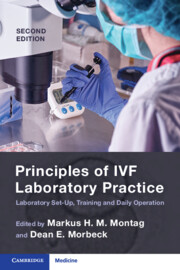Book contents
- Principles of IVF Laboratory Practice
- Principles of IVF Laboratory Practice
- Copyright page
- Contents
- Contributors
- Foreword
- The Evolution of IVF Practice
- Section 1 Starting a New Laboratory and Training Protocols
- Section 2 Pre-procedure Protocols
- Section 3 Gametes
- Section 4 Insemination/ICSI
- Section 5 Fertilization Assessment
- Section 6 Embryo Assessment: Morphology and Beyond
- Chapter 29 Polar Body Biopsy for IVF
- Chapter 30 Embryo Assessment at the Pre-compaction Stage in the IVF Laboratory
- Chapter 31 Embryo Assessment at the Post-compaction Stage in the IVF Laboratory
- Chapter 32 Embryo Assessment at the Blastocyst Stage in the IVF Laboratory
- Chapter 33 Trophectoderm Biopsy for Pre-implantation Genetic Testing
- Chapter 34 Embryo Culture by Time-Lapse: Selection and Beyond
- Section 7 Embryo Cryopreservation
- Section 8 Embryo Transfer
- Section 9 Quality Management
- Index
- References
Chapter 34 - Embryo Culture by Time-Lapse: Selection and Beyond
from Section 6 - Embryo Assessment: Morphology and Beyond
Published online by Cambridge University Press: 07 August 2023
- Principles of IVF Laboratory Practice
- Principles of IVF Laboratory Practice
- Copyright page
- Contents
- Contributors
- Foreword
- The Evolution of IVF Practice
- Section 1 Starting a New Laboratory and Training Protocols
- Section 2 Pre-procedure Protocols
- Section 3 Gametes
- Section 4 Insemination/ICSI
- Section 5 Fertilization Assessment
- Section 6 Embryo Assessment: Morphology and Beyond
- Chapter 29 Polar Body Biopsy for IVF
- Chapter 30 Embryo Assessment at the Pre-compaction Stage in the IVF Laboratory
- Chapter 31 Embryo Assessment at the Post-compaction Stage in the IVF Laboratory
- Chapter 32 Embryo Assessment at the Blastocyst Stage in the IVF Laboratory
- Chapter 33 Trophectoderm Biopsy for Pre-implantation Genetic Testing
- Chapter 34 Embryo Culture by Time-Lapse: Selection and Beyond
- Section 7 Embryo Cryopreservation
- Section 8 Embryo Transfer
- Section 9 Quality Management
- Index
- References
Summary
One of the most innovative changes to the practice of human embryo culture was the introduction of sophisticated time-lapse imaging (TLI) systems that eventually became part of the incubation unit. TLI allows continuous, uninterrupted monitoring of embryo development. Embryo selection at either the cleavage or the blastocyst stage using algorithms developed with tens of thousands or more of embryos with known implantation is robust and repeatable. The technology has continued to evolve, with improvements to the physical technology as well as software enhancements, including artificial intelligence (AI)-based embryo selection algorithms and machine learning.
Keywords
- Type
- Chapter
- Information
- Principles of IVF Laboratory PracticeLaboratory Set-Up, Training and Daily Operation, pp. 251 - 254Publisher: Cambridge University PressPrint publication year: 2023



